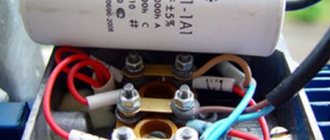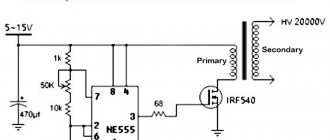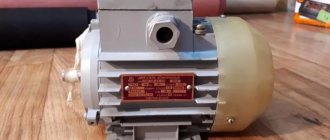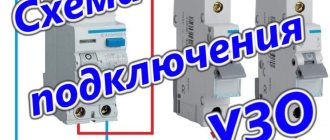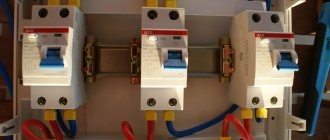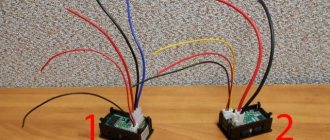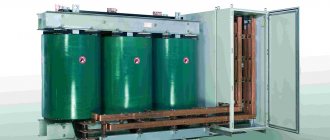How does a transformer work?
Already today, a huge number of current converters have been created; there are low-voltage and high-voltage models. The principle of operation of the transformer is quite simple - a step-down transformer is responsible for reducing the incoming current, while a step-up transformer, on the contrary, increases the voltage to a higher value.
For domestic purposes, this is a very important device; it ensures stable operation and complete safety of household electrical appliances.
Let's give a simple example. In many homes, a current of 385 Volts is supplied from the network, and standard household appliances operate only on 220V. In this case, you cannot do without a step-down transformer, so you will have to buy a single-phase or three-phase converter.
Important! If you have a three-phase network indoors, only a two-phase converter is matched to it. If the network is two-phase, the converter should only be used of the single-phase type.
Converter 380 Volt - industrial type, three-phase. Converter 220 Volt - standard household, single-phase.
When using a standard household transformer, its task will be simpler, because depending on the model, it changes the current to 12, 36, 42 Volts (depending on the requirements of household appliances).
The step-down current transformer has a simple design. It is based on a copper winding, which is wound on steel plates of the magnetic circuit frame.
The principle of operation of the design is simple - a larger value of current passes through one winding, after which a smaller current is issued from the second winding. This became possible due to the fact that there are more turns on one winding, and fewer turns on the second. Speaking in scientific language, this process is called electromagnetic induction.
Rod type magnetic core
To power radio-electronic devices, three-phase transformers with a common magnetic system through a yoke I for three phases with three rods C, or three-rod transformers are usually used. Each of the transformer windings, both primary and secondary, can be connected: a) by a star; b) a triangle.
When connected by a star, the ends of the windings form a common point 0. When connected by a triangle, the beginning of the first phase winding is connected to the end of the third, the beginning of the second - to the end of the first, and the beginning of the third - to the end of the second. In the first case, everything starts, and in the second, the common points of the windings are connected to the network.
It should be noted that the concepts of the beginning and end of the windings are conventional, but they are necessary for the correct connection of the phase windings. In three-phase transformers, the positive direction of the current from the beginning to the end of the winding must correspond to a certain direction of the magnetic flux in the rods; in core transformers this direction must be the same.
Winding connection: a - star; b - triangle.
The beginnings of high voltage (HV) phase windings are usually designated by capital (capital) letters A, B and C, and their ends by letters X, Y and Z, and for phase windings the letters AX, VU and CZ are used. The beginnings and ends of low voltage (LV) windings are designated, respectively, by lowercase (small) letters - a, b, c and x, y, g.
The most common winding connections are “star” (Y) and “delta” (D), and the primary and secondary windings can have either the same or different circuits. If, when connecting the windings with a star, the zero point is output, then such a connection is called “star with zero” (Yo).
Star connection of windings
The simplest and cheapest of them is to connect both windings of the transformer with a star (Y/Y), in which each of the windings and its insulation (with solid grounding of the neutral point) should be designed only for phase voltage and line current.
Star connection of transformer windings.
Since the number of turns of a transformer winding is directly proportional to the voltage, therefore, a star connection of the windings requires a smaller number of turns in each winding, but a larger cross-section of conductors with insulation designed only for phase voltage.
A three-phase transformer has windings connected in a star (Y/Y). This connection is widely used for small and medium power transformers (up to approximately 1800 kVA). The star connection is most desirable for high voltage, since in it the insulation of the windings is calculated only for the phase voltage. The higher the voltage and lower the current, the relatively more expensive it is to connect the windings with a delta.
Where is triangle winding used?
Connecting the windings with a triangle is structurally more convenient at high currents. For this reason, the Y/D connection is widely used for high power transformers where a neutral wire is not required on the low voltage side.
With three-phase transformation, only the ratio of phase voltages U1ph/U2ph is always approximately equal to the ratio of the numbers of turns of the primary and secondary windings w1/w2; As for linear voltages, their ratio depends on the method of connecting the transformer windings.
Connection of transformer windings with a triangle.
With the same connection method (Y/Y or D/D), the ratio of line voltages is also equal to the transformation ratio. However, with different connection methods (Y/D or D/Y), the line-to-line voltage ratio is √3 times less or more than this ratio. This makes it possible to regulate the secondary line voltage of the transformer by correspondingly changing the method of connecting its windings.
The operating characteristics of transformers are influenced by energy losses during heating of the windings in combination with other external and internal factors that significantly complicate the relationship of the secondary voltage shape with similar parameters of the primary circuit.
How to choose a step-down transformer?
If you have little knowledge of electrical engineering, choosing a step-down transformer will be difficult, and you will have to entrust this to specialists. But when deciding to choose the right device yourself, pay attention to the following indicators:
- The indicated power of household or industrial appliances must be less than that indicated on the transformer;
- The input voltage into which the device will be installed must be suitable;
- The output voltage must match the transformer.
Try not to choose cheap models, because a high-quality modern converter must withstand emergency situations and operate stably after they are detected. For example, short circuits, network overvoltage, and network overload often occur.
The device is selected specifically for your requirements; the main parameter is the input voltage. During visual inspection, the input voltage is written on the product. For example, a step-down transformer with 220 V or 380 V. The output voltage marking should also be indicated on the case, for example 12 or 36 Volts.
Be sure to pay attention to the power of the device, because when selecting a voltage stabilizer, you will have to add the power of all future devices used and add another 20% of the obtained figure.
Connection
To connect a transformer, you need to connect a load to the contacts of the secondary winding, and then apply household voltage to the contacts of the primary coil.
The connection diagram to the secondary winding depends on what voltage needs to be obtained at the output: if 24 V, we connect to the outer terminals, if 12 V, to one of the outer terminals and the terminal from the 120th turn.
Connection diagram for 12V spotlights via a transformer
If the consumer operates on direct current, a rectifier must be connected to the terminals of the secondary coil. For this purpose, a diode bridge equipped with a capacitor is used (it acts as a filter, smoothing out ripples).
If there is electricity at the dacha, then there must be grounding. Grounding for a summer residence is an effective way to protect against electric shock.
We'll tell you how to check a capacitor with a multimeter below.
Installation Features
Safety regulations regulate the correct installation of step-down transformers for their stable long-term operation. It is important to install the device in places that are maximally protected from water, dust and various oils. Most craftsmen install transformers in protective enclosures or cabinets.
It is also important to ensure that a person cannot touch the transformer while it is running. It is imperative that a specialist ground the transformer with a copper wire. Try to choose a wire with a minimum cross-section of 2.5 mm. Also, to avoid serious damage, you will have to inspect and repair the device from time to time.
Useful tips
Some useful tips on how to connect a 3-wire motor to avoid problems during operation:
- Before starting work, it is recommended to test the engine at idle, if it is functioning properly, then under load.
- If the case becomes very hot, even without load, it is necessary to reduce the capacity of the working capacitor.
- If after starting the motor just hums, but does not rotate the shaft, then you can set it to start manually - by turning the shaft. Next, you can increase the capacity of the starting capacitor.
- When stopping the engine under operating load, the capacity of the working capacitor should be increased.
Helpful information! It is possible to correctly calculate the capacitance of the capacitor only taking into account the power rating of the motor. If there is underload, overheating will occur and the capacity will need to be reduced.
Photos of step-down transformers
Read here! Diesel Generators: Importance Nowadays

